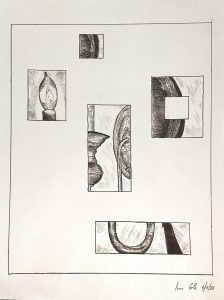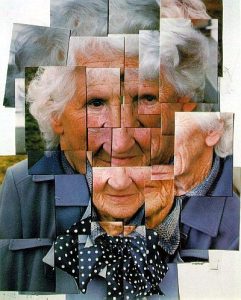Love the way you broke this into parts. They’re perfectly arranged and aligned to both hold the space and maintain their independence while also converging on the same image–wonderful job. I’d go one step farther and let go of the outer border, which feels redundant and less daring. The black outline on mine is the edge of the paper (I also tweaked the contrast and the white balance to remove that pink haze and make the lines black).
David Hockney



For this drawing, I chose to draw the light fixture above my bed because it’s played an important role during this period of quarantine, since I spend a lot of time alone in my room with that light on– for reading, homework, etc. The light itself is representative of my feelings of isolation as a result of social distancing, but also a positive force of introversion and self-discovery. I chose to divide the light fixture up into pieces and scramble them around on the paper in order to convey the feelings of separation, emptiness, and confusion, all significant emotions in the current crisis. The rectangle pieces also resemble the rectangles in zoom calls. Overall, I think I made a solid composition. If I were to change a few things about it, I would probably eliminate some of the negative space (but not too much) and tone down my shading on a couple sections. As a composition, though, I think it’s fairly unified and interesting, and I’m happy with the overall artistic statement.
I really like all the shading you have going on at the base of the sconce. There is that tube-like metal piece that extends from the center of the fixture out to hold up the rest of the lamp, and I think that you have really succeeded in making that look rounded. The varied shading that you have is very important since it looks like you have a lot of nooks and cranies to showcase. I also really like the concept of this piece. The traditional object with the jumbled composition is such a good contrast. One thing that I think could be better would be the consistency of color. The pieces that are separated from each other by negative space are different in size and shading, and if they were pieced back together to create a whole i’m not sure they would align well.
Hi Isaac,
My apologies for the delayed response to your drawing, but I was thrilled to see it the moment it came in.
I love that you chose such an intimate experience to dwell on, but even more so how you’ve developed that idea, both conceptually and technically. A very major step forward from your compositional decisions the week before.
Conceptually, it brings to mind the work of French philosopher Henri Bergson (1859-1941). In my lay understanding, he proposed that we perceive reality in little glimpses that the brain then weaves together into a semblance of rational continuity (goggle him for a far richer explanation, but this much will be enough to make my point). I’ve heard this likened to a film projector—while the image on the screen moves smoothly, the film is actually a series of still images running in sequence. The projector—like the brain—creates the illusion of movement by showing us 24 frames per second.
His thinking also parallels the work of his contemporary Cezanne, who began to show these disparate glimpses in his paintings, so that a table would disappear behind a wine bottle at one point but re-emerge at a different point, so that the painting was subtly a “stitched together” view of the world, which became the essence of cubism.
I could include an example from any of those artists, but the one from David Hockney maybe comes closer, since his photographic snippets stand alone, like yours (rather than melding together, as do the cubists).
In any case, a highly sophisticated analysis of how we see, and you even found an eloquent language of your own to describe it. I like the fact that some pieces of the “puzzle” fit together and others don’t. There are always missing pieces and misalignments in how we see (not to mention in our lives, and never more so than the current moment); the perfect metaphor for a time in which each of us is struggling to get our bearings.
Technically this is wonderfully executed as well, Great that you chose the pen hatching and applied it so consistently. Love the way you doted on details, like the screw heads on the base.
A very nice surprise that one of the fragments is excised from one of the others, suggesting subsets of the Bergson-like glimpses mentioned above.
My only suggestions are in my notes above—edit your image a little better and lose the outer border which is redundant.
Terrific drawing, Issac.
Hi Isaac. I love this idea and you have executed it wonderfully! There is a good balance between negative space and drawing. I like that you have loosely organized each piece into their general area. My only composition suggestion is that my brain immediately wants to put the two halves of the circle together and they do not fit. I think that is a great desire you are playing on, however because they are so close together, it feels like they are pulling together in a way that the rest of the image is not. I think you could either zoom in/out further on one part so that the shapes feel less similar or yank them a little farther apart.
Additionally, I really like your hatching work in the image with the bulb. It is very clear where the light is coming from. It might be interesting to play with perspective further and give the wall behind the other objects a stronger sense of light as well. (You have done it beautiful on the objects themselves.) You could either follow the light as it would appear to be if the lamp was reassembled or you could use the current composition and see where light would fall if it was radiating out from the bulb to the rest of the drawing. (That could maybe be a crazy idea, so take that with a grain of salt.)
Great work!